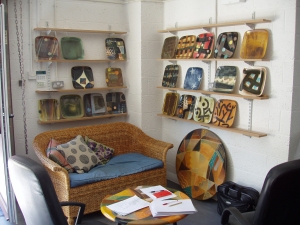Introducing Thelonius
Before introducing you to Thelonius, belatrova would like to invite you to the Hereford Contemporary Craft Fair. Please come and see us and the work of 59 other selected makers of contemporary craft exhibiting over three days at The Courtyard (Hereford), where you can commission a piece of original work or buy direct from makers. It is open 10am to 6pm Friday 15th and Saturday 16th, 10am to 5pm on Sunday 17th November. The Courtyard has full disabled access and a café and restaurant that serve excellent locally sourced food and drink. Entry is £4 (free access for carers) and visitors can win a belatrova piece by just entering the daily Prize Draw at our stand by simply leaving their names and email addresses.
Now, Mrs belatrova has recently remarked on the amazing muscularity of Mr belatrova’s right arm, and the strange contrast it offers when seen alongside his other rather weedier left one. This can be easily explained. It is the result of being right handed and having to thump the daylight out of lumps of recycled clay in order to “pre-process” it to get it to a smooth consistency before it can be used again.
In order to correct this imbalance, and to stop belatrova looking like a gangster with a bulging holster under his jacket, a decision was taken to invite a new member to the team who would take on the sole task of pugging.
Allow us to introduce Thelonius Pugmill; he’s from Essex and has until now spent his working life at a school in Colchester.
A pugmill is like a large mincer or sausage machine with knives on the screw fan principle that cut and knead the recycled clay, pressing it out of a smaller aperture (3″), smooth and even in texture, and ready to be used.
Most pug mills require you to process the clay to get it to a relatively tight range of consistency before going in. Dry clay has to be soaked in a bucket and wet clay kept wrapped in a plastic bag so that it is just right for the mill. The clay is squeezed out in long tube shapes called “slugs”, which are carefully stacked and wrapped in plastic until required.
The following images will give you an idea of how it all works:
If you want to follow belatrova’s progress via Facebook or the blog, and unless you have already done so, just click the tag at the bottom right of your screen that says “follow” and you will get notifications everytime the blog is updated with news. We will be opening at No 9 for Christmas – details in the next blog.




























